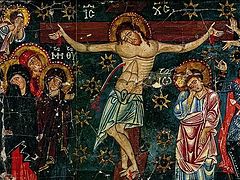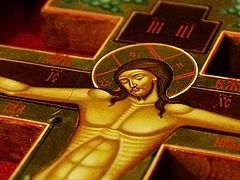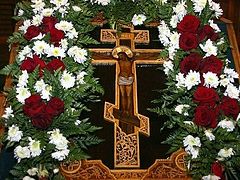One of the many images we find in the Scriptures are those of garments and their relationship to God and God’s salvation.
In the hymns of the Church and in the writings of many Patristic writers we note that Eve and Adam are stripped naked by their own sinfulness. A nakedness that God in His love and mercy chooses to cover as God covers both our sin and shame:
In Paradise of old, the wood stripped me bare, for by giving its fruit to eat, the enemy brought in death. But now the wood of the cross that clothes mankind with the garment of life has been set up in the midst of the earth, which is filled with boundless joy. As we behold it exalted, people, in faith, let us cry out to God with one accord: Your house is full of glory! (Matins hymn, Feast of the Elevation).
In Genesis 3:21, after Eve and Adam had sinned, it is God Himself who is said to cover their nakedness:
And the LORD God made for Adam and for his wife garments of skins, and clothed them.
It is an act of mercy on God’s part for His human creatures who have through sin rebelled against Him. But we are pitiable creatures in God’s eyes, and God provides for us so that we can survive in the world of the Fall. The hymns of the Cross suggest it is through the Cross that we are clothed again with a garment of life.
Garments play a significant part the sacramental life—through baptism we are given a special spiritual garment, which we ask God in the petitions to help us “keep the garment undefiled” and for which we will have to give an account on Judgment Day (“and preserve the baptismal garment undefiled unto the day of Christ our God”).
Preserve pure and unpolluted the garment of incorruption with which You have clothed him (her), by Your grace, the seal of the Spirit, and showing mercy to him (her) and to us, through the multitude of Your mercies.
The priest declares immediately after baptizing the person that:
The servant of God, ______, is clothed in the robe of righteousness, in the name of the Father, and of the Son, and of the Holy Spirit.
And then everyone at the baptism sings:
Grant to me the robe of light, O Most Merciful Christ our God, Who clothe Yourself with light as with a garment.
And
As many as have been baptized into Christ, have put on Christ (Galatians 3:27).
The newly baptized is said to clothe him/herself in Christ our God. This also resonates with the Transfiguration account in which the very clothes of Christ are said to show forth a brilliant whiteness (Mark 9:3; Matthew 17:2; Luke 9:22).
In Isaiah 61:10, we read these words which the priest prays as he vests himself before the Liturgy:
I will greatly rejoice in the LORD, my soul shall exult in my God; for he has clothed me with the garments of salvation, he has covered me with the robe of righteousness, as a bridegroom decks himself with a garland, and as a bride adorns herself with her jewels.
In 2 Esdras 2:39, we encounter this prophecy of what we will receive in the glorious age to come:
Those who have departed from the shadow of this age have received glorious garments from the Lord.
St. Isaac of Nineveh writes:
For the Cross is Christ’s garment just as the humanity of Christ is the garment of the divinity (Contemplating the Cross).
We put on Christ, Christ puts on our humanity. We are clothed in each other. The Tree of the Knowledge of Good and Evil stripped us bare when we ate of its fruit. Now the cross clothes Christ who is stripped naked and nailed to it. The images of clothing and salvation are common throughout the scriptures.
Here indeed we groan, and long to put on our heavenly dwelling, so that by putting it on we may not be found naked. For while we are still in this tent, we sigh with anxiety; not that we would be unclothed, but that we would be further clothed, so that what is mortal may be swallowed up by life (2 Corinthians 5:2-4).





